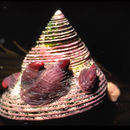Look Alikes
provided by Invertebrates of the Salish Sea
How to Distinguish from Similar Species: This species is the only one in this area with a very tall, arched, beaklike, recurved apex and a brown periostracum
- license
- cc-by-nc-sa
- copyright
- Rosario Beach Marine Laboratory
Habitat
provided by Invertebrates of the Salish Sea
Rocky coast, mainly on Tegula funebralis shells
- license
- cc-by-nc-sa
- copyright
- Rosario Beach Marine Laboratory
Habitat
provided by Invertebrates of the Salish Sea
Depth Range: Mid to low intertidal
- license
- cc-by-nc-sa
- copyright
- Rosario Beach Marine Laboratory
Comprehensive Description
provided by Invertebrates of the Salish Sea
This species is cap-shaped with an apex nearly as tall or taller than the shell is wide. The apex is prominent and usually arched, beaklike. The periostracum is dark brown. The inside contains a white shelf or septum. In this species the shelf is on the posterior end, as is the recurved apex. The species grows to about 2.5 cm long.
- license
- cc-by-nc-sa
- copyright
- Rosario Beach Marine Laboratory
Comprehensive Description
provided by Invertebrates of the Salish Sea
Biology/Natural History: This filter-feeding species specializes in living on Tegula funebralis, Calliostoma ligatum, and Searlesia dira shells. It is a protandric hermaphrodite. A newly settled individual is male. As the individual grows another individual may settle on its shell, and the bottom individual becomes female. This species broods its eggs, which have direct development. The eggs are kept in capsules under the mother's shell. When the young are ready for release the mother lifts her shell 1-3 mm above the substrate and pushes them out with her head. Newly liberated young are like small adults, 1.9 mm long. They usually fall off the Tegula shell and grow to about 4 mm before they find another host. A related species, Crepidula fornicata, is native to the Atlantic but has been introduced to a few areas in the Northwest with oysters.
- license
- cc-by-nc-sa
- copyright
- Rosario Beach Marine Laboratory
Distribution
provided by Invertebrates of the Salish Sea
Geographical Range: Queen Charlotte Islands to Punta Santo Tomas, Baja California
- license
- cc-by-nc-sa
- copyright
- Rosario Beach Marine Laboratory

